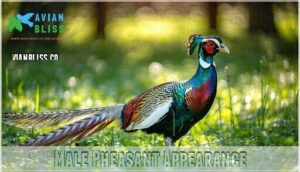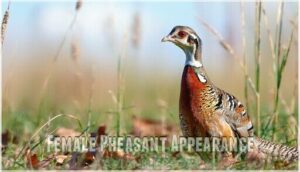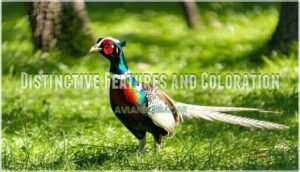This site is supported by our readers. We may earn a commission, at no cost to you, if you purchase through links.
 You’ll spot a ring necked pheasant by its dramatic takeoff that sounds like a miniature helicopter.
You’ll spot a ring necked pheasant by its dramatic takeoff that sounds like a miniature helicopter.
Males are nature’s showoffs—sporting iridescent green heads with white collar rings, copper bodies, and impossibly long tails that make peacocks jealous.
Females are master camouflage artists with mottled brown plumbing that blends perfectly into grasslands.
These Asian natives adapted brilliantly to North American farmlands, thriving in the sweet spot between crop fields and wild cover.
They’re ground-dwelling omnivores who’d rather run than fly, using explosive bursts of speed when cornered.
Despite their adaptability, habitat loss has these stunning gamebirds facing serious population challenges across their range, which is a significant threat to their survival in the wild cover.
Table Of Contents
- Key Takeaways
- Ring Necked Pheasant Overview
- Physical Characteristics
- Habitat and Distribution
- Behavior and Diet
- Conservation and Ecology
- Frequently Asked Questions (FAQs)
- Are Ring-necked Pheasants native to the US?
- How much is a ringneck pheasant worth?
- Are Ring-necked Pheasants good to eat?
- Are ringneck pheasants loud?
- What do ring-necked pheasants eat?
- What does a ring-necked pheasant look like?
- Are ring-necked pheasants common?
- Are ringnecked pheasants native to South Dakota?
- Are ring-necked pheasants native to North America?
- What are ringneck pheasants good for?
- Conclusion
Key Takeaways
- You’ll recognize males by their brilliant copper-gold plumage, white collar rings, and iridescent green heads, while females use mottled brown camouflage that makes them nearly invisible in grasslands.
- You’re seeing an introduced species from Asia that’s thrived in North American farmlands since the 1880s, preferring the mix of crop fields and wild cover for optimal habitat.
- You’ll notice these ground-dwelling birds would rather run than fly, using explosive bursts of speed when cornered and creating that distinctive helicopter-like takeoff sound.
- You’re witnessing a species facing serious population decline—US numbers have dropped 50% since 1990 due to habitat loss from intensive agriculture, despite their remarkable adaptability.
Ring Necked Pheasant Overview
If you’ve ever spotted a brilliantly colored bird strutting through farm fields, you’ve likely encountered the ring-necked pheasant (Phasianus colchicus).
This introduced game bird has thrived across North America since the 1880s, becoming a familiar sight in agricultural landscapes from coast to coast.
Scientific Name and Classification
You’ll discover the ring-necked pheasant’s scientific classification reveals fascinating taxonomic history.
Phasianus colchicus belongs to order Galliformes and family Phasianidae, though subspecies debate continues among researchers.
The naming etymology traces back to ancient Colchis, while evolutionary origins span millions of years.
This genetic diversity creates ongoing scientific classification challenges for ornithologists studying these remarkable gamebirds.
Global Distribution and Population
You’ll find Phasianus colchicus thriving far beyond its Asian homeland.
These remarkable gamebirds have conquered continents, transforming from Asian natives into America’s beloved countryside icons.
This introduced species now spans over 50 countries, with North America hosting the largest wild population outside Asia. However, their success story comes with concerning population dynamics.
- Regional Variations: Midwest strongholds like South Dakota support millions, while native Chinese populations decline
- Habitat Expansion: Agricultural landscapes from British lowlands to Great Plains fuel their spread
- Population Decline: US numbers dropped 50% since 1990 despite release programs
- Climate Impact: Extreme weather increasingly threatens reproductive success across their range
Population density varies dramatically—some Midwestern areas report 40 birds per square mile, while European numbers rely heavily on annual releases of 49 million birds in the UK alone.
This decline is part of a larger trend, with habitat loss impacting birds globally.
Physical Characteristics
You’ll instantly recognize a ring-necked pheasant by its striking sexual dimorphism—males sport brilliant copper-gold plumage with iridescent green heads and distinctive white neck rings, while females wear practical mottled brown camouflage that makes them nearly invisible in grasslands.
These birds showcase nature’s perfect balance between beauty and survival, with males built for display at 20-28 inches long and females designed for stealth at 16-20 inches.
Male Pheasant Appearance
You’ll immediately recognize a male ring-necked pheasant by his spectacular iridescent plumage that shimmers with copper, gold, and green hues.
His distinctive white collar encircles a brilliant red face adorned with fleshy red wattles that become more prominent during breeding displays.
The male’s long, barred tail feathers extend dramatically behind his robust body, while his pale yellow legs complete this stunning appearance that’s designed to attract mates, showcasing his overall spectacular presence.
Female Pheasant Appearance
Unlike their flashy male counterparts, brown females sport practical camouflage plumage that’s perfectly designed for survival.
You’ll notice their mottled brown feathers create natural camouflage, while barred buff and black upperparts blend seamlessly with grassland surroundings.
Their plain buff underparts complete this nesting coloration strategy, making them nearly invisible when brooding eggs or protecting chicks from predators.
Distinctive Features and Coloration
Spotting these remarkable birds becomes easier when you understand their key visual markers. Male pheasants showcase brilliant feather iridescence across their copper-gold plumage, while females rely on expert camouflage through mottled brown patterns that blend seamlessly into grassland environments.
Understanding their leg length and color can further aid in distinguishing between sexes and age groups.
Key identification features you’ll notice:
- Male plumage displays vibrant greens, purples, and bronze with distinctive white collar rings
- Wattle display features bright red facial skin surrounding the eyes and cheeks
- Tail morphology shows long, pointed feathers in males versus shorter, rounded tails in females
- Female camouflage utilizes intricate buff and black barring for perfect concealment during nesting
Size and Body Structure
Three distinct size classes define the ringnecked pheasant’s physical description through striking sexual dimorphism.
Males reach 24-35 inches with impressive wingspan variation up to 30 inches, weighing 2-3 pounds.
Female weight averages lighter at 1.5-2 pounds with 25-inch wingspans.
Their skeletal structure supports dramatic tail length differences—males sport elaborate plumage extending their profile substantially beyond females’ modest tails.
Habitat and Distribution
Beyond their striking appearance, these stunning birds showcase remarkable Habitat Adaptations that’ve helped them thrive far from their Asian homeland.
The Ringnecked Pheasant’s Introduced Range now spans vast territories across North America, where they’ve mastered the art of making themselves at home in our backyards.
You’ll find these adaptable gamebirds flourishing in diverse environments, from the prairie heartland to coastal regions.
Their secret? A knack for reading the landscape like a well-worn map:
- Agricultural areas mixed with tall grass provide perfect cover
- Field habitat along weedy roadsides offers abundant foraging
- Preferred Vegetation includes hedgerows and old fields
- Regional Density peaks at 30-40 birds per square mile in ideal Midwest locations
Their impressive Climate Tolerance allows survival from temperate zones to semi-arid regions, though harsh winters challenge northern populations without adequate shelter.
Behavior and Diet
You’ll find ring-necked pheasants fascinating to watch as they scratch and peck their way through fields, using their strong bills and feet to uncover everything from seeds to insects.
These adaptable birds shift their dining habits with the seasons, forming social flocks outside breeding season while males put on spectacular territorial displays that include loud crowing and dramatic wing-flapping performances.
Foraging Habits and Techniques
When you watch pheasants forage, you’ll notice their signature scratch-and-peck technique—they use powerful feet to rake through soil and debris, then methodically probe with their bills.
Their foraging strategies focus on edge habitats where food and cover intersect, allowing quick escapes from predators.
This behavioral adaptation makes their pheasant diet incredibly diverse through efficient prey selection.
They’re omnivores, so their diet includes a variety of foods, and they typically exhibit ground-foraging behavior.
Seasonal Diet Variations
You’ll discover ring necked pheasant diet changes dramatically with seasons.
Spring insect consumption peaks as chicks need protein, while adults munch corn shoots.
Summer berry abundance provides vitamins alongside grasshoppers and beetles.
Autumn grain dependence kicks in—corn and soybeans fuel fat reserves.
Winter food scarcity forces reliance on waste grain and standing seeds, requiring 40% more calories than fall.
These birds are classified as Phasianus colchicus with a notable diet change.
Mating Rituals and Displays
You’ll witness nature’s most dramatic show during spring when males transform into feathered performers.
Spring transforms male pheasants into nature’s most spectacular feathered performers, strutting with breathtaking displays.
Territory Defense becomes their obsession as they establish territories averaging 0.5-2 hectares, using aggressive chasing and physical combat against rivals.
- Calling Display: Sharp two-note crowing carries up to 1 kilometer across open habitat
- Visual Spectacle: Wing-flapping, neck stretching, and tail fanning in direct sunlight
- Harem Formation: Successful males control multiple females’ Nesting Sites
- Courtship Behavior: Displays peak at sunrise during early spring months
- Chick Development: Only 10-25% of males successfully mate each season
To attract mates, some hunters utilize specialized pheasant calls.
Flocking Behavior
You’ll notice ring-necked pheasants aren’t loners—they’re surprisingly social creatures with complex flock dynamics.
During winter months, these birds gather in mixed groups of 5-20 individuals, creating social hierarchies based on age and size.
Group foraging becomes their survival strategy, with collective eyes watching for danger while others feed.
This seasonal flocking behavior peaks when resources grow scarce, demonstrating sophisticated animal behavior patterns that enhance their chances of weathering harsh conditions together.
This enhances enhanced predator protection due to increased vigilance.
Predator Avoidance Strategies
Ring-necked pheasants employ sophisticated predator avoidance strategies that showcase their remarkable adaptability.
You’ll observe these birds using multiple defense mechanisms to survive in challenging environments. One key survival method involves plumage camouflage methods.
- Camouflage Techniques: Females blend seamlessly into vegetation while males use colorful plumage as decoys
- Flight Patterns: Explosive takeoffs with zigzag movements confuse pursuing predators
- Group Defense: Collective vigilance and alarm calls enhance survival rates substantially
Their habitat selection prioritizes dense cover for quick escapes.
Conservation and Ecology
You’ll discover that ring-necked pheasant populations face significant challenges despite their successful introduction to North America over a century ago.
Understanding the complex factors affecting their conservation helps explain why these resilient game birds need active management to maintain stable numbers across their range, which involves active management.
Current Population Estimates
Population estimates for wild pheasant populations remain challenging due to their secretive nature and varied habitat preferences.
Current demographic trends show significant regional variations across North America, with Midwest states reporting 30-40 birds per square mile in prime habitat.
However, population monitoring reveals concerning downward trends in many areas, which depend heavily on habitat impact assessments for accurate analysis.
Future projections depend heavily on improved estimation methods for accurate population trends analysis.
Factors Affecting Population Decline
Multiple factors threaten Ringneck Pheasant populations across their range.
Habitat loss from intensive agriculture eliminates critical nesting cover, while modern farming practices destroy traditional hedgerows.
Predation pressure from expanding coyote populations devastates ground-nesting birds, and disease impact weakens immune systems.
Reduced genetic diversity limits adaptation, and you’ll find these interconnected threats create a perfect storm for declining pheasant numbers nationwide, which is a result of the combined effects of habitat loss, predation, and reduced genetic diversity.
Conservation Efforts and Management
Wildlife managers are fighting back with science-backed strategies.
You’ll see habitat restoration programs replanting native grasses and establishing food plots.
Hunting regulations now include bag limits and season restrictions to prevent overharvest.
Predator control helps protect nesting birds, while captive breeding programs maintain genetic diversity.
These sustainable management practices combine traditional wildlife conservation with modern pheasant conservation efforts for long-term success.
Impact of Hunting on Populations
You’ll find that pheasant hunting creates a fascinating paradox in wildlife management.
While hunting provides essential funding for habitat conservation through license fees and excise taxes, it also removes breeding birds from populations.
Modern hunting regulations carefully balance harvest sustainability with population health, setting bag limits and season dates based on annual surveys.
Hunter ethics play a pivotal role here—experienced hunters target roosters primarily, protecting hens needed for reproduction.
The economic impact reaches beyond conservation, supporting rural communities through hunting-related tourism and equipment sales, which is a result of the balance between population health and the need for habitat conservation.
Climate Change Effects on Pheasants
Climate change is reshaping pheasant territories faster than you’d imagine.
Rising temperatures force range shifts northward, while habitat loss accelerates as wetlands dry up.
Extreme weather disrupts breeding cycles, reducing chick survival rates dramatically, and food availability fluctuates wildly during unpredictable seasons.
Weather extremes create perfect storms for population crashes, making conservation efforts increasingly critical for these adaptable yet vulnerable birds, facing climate change and population crashes.
Frequently Asked Questions (FAQs)
Are Ring-necked Pheasants native to the US?
Straight from the horse’s mouth: No, you won’t find Ring-necked Pheasants as native birds here.
These colorful game birds were introduced from Asia during the 1880s, making them successful transplants rather than original inhabitants.
How much is a ringneck pheasant worth?
Ring-necked pheasants don’t have a fixed "worth" since they’re wild birds, but hunting licenses cost $20-50, and released birds for hunting preserves typically run $8-15 each.
Are Ring-necked Pheasants good to eat?
You’ll discover these "harvest birds" offer exceptional table fare.
Their lean, white meat delivers a delicate, slightly gamey flavor that’s prized by hunters and chefs alike for its tender texture.
Are ringneck pheasants loud?
Yes, male pheasants are quite loud! You’ll hear their distinctive rooster-like crowing from up to a mile away, especially during spring mating season when they’re establishing territories and attracting mates.
What do ring-necked pheasants eat?
You’ll find these adaptable birds munching on a buffet of seeds, grains, berries, insects, and arthropods. They’re ground-foragers who scratch and dig, making them nature’s feathered treasure hunters.
What does a ring-necked pheasant look like?
You’ll spot males by their striking copper-gold plumage, white neck ring, and red face wattles. Females wear mottled brown feathers for camouflage. Both have long tails and sturdy builds.
Are ring-necked pheasants common?
By pure chance, you’ll encounter these game birds thriving across North America’s agricultural heartland.
Ring-necked pheasants aren’t just common—they’re abundant in suitable habitat, with Midwestern populations reaching 30-40 birds per square mile in prime farmland areas.
Are ringnecked pheasants native to South Dakota?
Ring-necked pheasants aren’t native to South Dakota—they’re Asian immigrants that made themselves at home.
You’ll find these colorful birds thriving across the state after being introduced in the 1880s for hunting purposes.
Are ring-necked pheasants native to North America?
You might think these colorful game birds belong here, but they’re actually Asian natives.
Ring-necked pheasants aren’t native to North America—they were introduced from Asia in the 1880s for hunting purposes.
What are ringneck pheasants good for?
You’ll find these birds incredibly valuable for hunting, providing excellent table fare with their lean, flavorful meat that’s prized by sportsmen and chefs alike for its distinctive taste.
Conclusion
Like a flickering candle in an endless storm, the ring necked pheasant faces an uncertain future despite its remarkable adaptability.
You’ve witnessed these resilient gamebirds transform farmlands into thriving habitats, yet their populations continue declining.
Their survival depends on our collective conservation efforts—protecting critical grassland corridors, supporting sustainable farming practices, and maintaining the delicate balance between agriculture and wildlife habitat.
Without immediate action, future generations may only know these spectacular birds through stories rather than the thunderous whir of their dramatic takeoffs across open fields, a loss that would undermine the delicate balance between human activity and wildlife preservation.
- http://feederwatch.org/learn/common-feeder-birds/
- https://www.pa.gov/agencies/pgc/wildlife/discover-pa-wildlife/ring-necked-pheasant.html
- https://birdfact.com/articles/what-do-pheasants-eat
- https://www.pheasantsforever.org/Habitat/Pheasant-Habitat-Essentials-Guide.aspx
- https://www.friendsofcapewildlife.org/ring-necked-pheasant/









